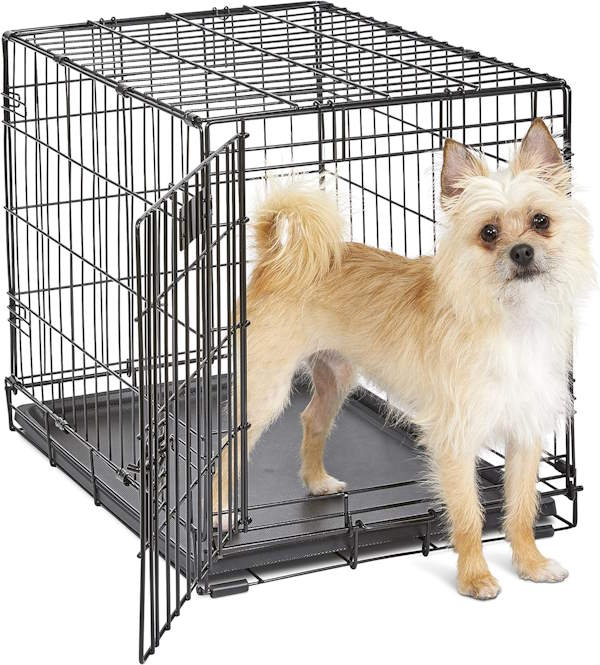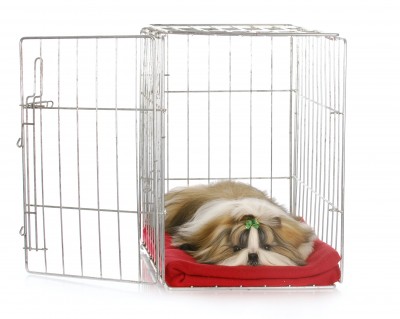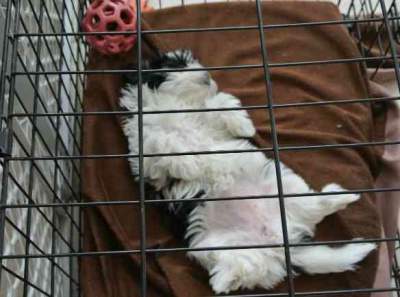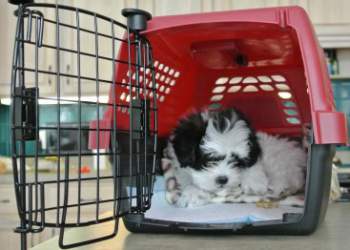- Small Dog Place Home
- Training
- Crate Training Small Dogs
Crate Training Small Dogs:
A Win-Win Situation for you and your dog
by Janice Jones |Last Updated 03-24-2024
Crate training small dogs might seem like a daunting task, but it sure does not have to be.
Many people equate house training or housebreaking a puppy to crate training because crates have made the job so much easier.
A crate or cage is a type of enclosure with four sides, a top and a floor. Most crates are made of plastic or metal and have one or two doors that can be used by your puppy to enter or leave.
If you want something a little nicer than the everyday metal crate, check out the crates that resemble hardwood furniture.
Many models come in any color of the rainbow with coordinating accessories
If airline travel is in your plans, consider
a fabric or vinyl crate that will hold your pooch. You will be able to count it as a carry on
item, and your dog will be safely by your feet in the cabin. House training is not the only reason for crate training small dogs.
A Crate Can Function as a:
- Crates work great for transportation, either as an
enclosure during a road trip, carry on piece of luggage for air travel, or
as a shipping container if puppy needs to be shipped.
- Crates serve as a secure bed and enclosure in hotel
rooms and are often required by hotel regulations.
- Crates become the dog’s personal sanctuary—a safe place
to hide, sleep, and watch the world go by.
- Crates can protect a puppy from dangerous household
items such as poisonous plants, electrical cords, medicines, etc., if the
house is not properly puppy proofed.
- Crates are used to confine dogs while the owner is at work or away from the home.
When introduced at a young age, most
puppies feel very safe in their crate and will go in it whenever they want to
sleep or get away from the normal commotion of a busy household.
Consider a crate a must-have if you have more than one dog. In multiple dog households, unless two dogs get along very well, they should each have their own crate.
What Size Crate to Purchase?
How Big is Too Big
When Crate Training Small Dogs?
The crate should be big enough so that the dog can stretch out to sleep, stand up and not bump their head, turn around and sit comfortably.
Overly large crates allow dogs to sleep and eliminate within its confines, thereby eradicating any training plan it might serve.
My recommendation? Save money and buy a larger crate and find a way to partition it off, so the puppy only has access to the size he needs now.
How do you do it?
Some crate manufacturers have already figured it out and sell their product with metal or plastic divider that can be removed when the puppy grows.
This usually works well for most puppies, but I have heard horror stories of active dogs trying to move the barrier and get lodged between the areas.
This is a sad tragedy and something to think about if you have a high energy dog, who will need to remain in a crate for extended times.
Crate Training Small Dogs:
What to do to make a big crate small
enough for your puppy
You can fill the extra space with a box or plastic container
This has worked well for us. The final solution is to build a ½ wall and line one side with soft bedding and the other side with potty pads. This last alternative is not recommended but may be a last resort.
An alternative to crate confinement would be to use a small room or corner of the room that can be divided and blocked with infant gates or x-pens. The puppy would have their own room with their bed in the crate, water, toys and some pads to use in case of an emergency.
Some people make use of X-pens
when crate training small dogs
Many owners who work rely on one of these options for their puppy while they are away from the home. The puppy uses the pads and outdoors. This doesn’t work for all dogs and many experts will tell you that this just confuses the puppy.

Crate Accessories for Crate Training Small Dogs
Basic Crate
At a minimum you will need a crate.
Travel Crate
Some prefer to use a travel crate because they are more portable. This one pictured to the right comes in a variety of colors.
3-Door Portable Collapsible Pet Kennel for Crate-Training Dogs (Check price on Amazon)
Furniture Doubles as a Crate
For those with limited space, a crate that can also double as an end table is the perfect choice.
Furniture that Doubles as a Crate (Amazon link)
Make Crate Training Small Dogs Colorful
Take it one step farther and get a cover, bed and matching crate
all in your favorite color.
Additonal Assessories
You can get as fancy or simple as you like with fixing up a crate. At a minimum, you will need a crate pad or soft bedding for the dog.
If you want to get real cozy, you can purchase or make a crate cover that covers the crate on all four sides. Each side is sewn separately, so you can choose whether to keep all side flaps down or let your dog see the world through the front gate.
Dog Crate with cover and pad (Check price on Amazon)
Comfortable Bed
Blankets or towels will also serve the purpose, but small dogs tend to love comfort and a thick pad or pillow is most appreciated.
Many people will purchase a dog bed and place it inside the crate for their dog’s comfort.
Dog bed for dog crate (Check price on Amazon)
Attached Water Bottles
Water bottles can be attached to the crate walls or small water bowls specifically designed to work with crates can be attached to the door or walls of the crate.
Pet Water Bottle Hanging Dog Water Dispenser
If the crate is being used while you are away from home, a
few little chews are most appreciated by small dogs and will keep them munching
for a long time.
You can even purchase little crate fans to keep your pet cool in hot weather. Here are some accessories you might like when crate training small dogs in your home.
Crate Training Small Dogs: Your puppy's Introduction to the Crate
If this is the first time your pup has ever been in a crate, you will be much more successful if you train him to enter the crate on his own rather than picking him up and putting him there.
Start with a very tasty snack and a favorite toy. Toss the toy in first and see if he will follow. If so, reward with a treat and leave the door open for the puppy to go in and out.
If you want to associate a training command with entering the crate decide which word you will use. We always taught the word “Bed.” Say the dog’s name and the command. ‘
“Zoey, Bed”
If she goes in, great reward and act enthusiastically. If not, you may need to lure her in with the treats and toys, still keeping the door open initially.
Place the crate near you so the dog associates the crate with treats and being in close proximity to her favorite human.
Eventually, the dog will start going into the crate on her own to nap. At this point, you can try closing the door. Keep the training positive.
I like to talk to the puppy if she starts to whimper rather than immediately rescuing her by opening the door.
Using The Crate for House Training Purposes
The notion about using crates as house-training tools lies in the fact that instinctively dogs do not want to mess in their den or nest.
This goes back long before the first dog was domesticated. When puppies are born, the mother dog will work tirelessly to keep the area clean where her pups sleep by cleaning and eating any stool produced.
Puppies learn at a very young age that the place where you sleep must be keep clean.
Crate training is very popular and effective method of housetraining. Since the puppy does not want to mess where he sleeps, he will learn to wait until he is released from the crate to potty. This is only as efficient as the size of the puppy’s tiny bladder.
Why Crate Training Small Dogs Really Works
The puppy remains in the crate when he is not eating or drinking, playing with family members, or exercising outdoors—basically the puppy is in the crate when you cannot be in direct contact with him.
When you are ready to take him out, feed him or communicate, he comes out of the crate where you can supervise.
You will not want to confine your puppy to its crate for extended periods of time. Remember a young puppy cannot go much beyond 2 hours before they need to eliminate. This period lengthens as the puppy grows.
They can, however, go longer at night while asleep. This makes sense. Think about the average person.
We may use the bathroom several times during the day, but sleep all night without getting up to visit the restroom.
If the crate is large enough for the puppy to stand up, turn around, stretch out and lie down, it is of sufficient size and the puppy is not likely to have an accident in it provided it doesn’t have to remain in it for extended periods of time.
You have a win-win situation. The puppy does not mess in the house and will be ready to eliminate outside as soon as you are ready to take him.
When Work Schedules Interfere with Puppy Schedules
Crate Training Small Dogs Tips
- Never corner your pet in their crate.
- Even if you need to give medicine, groom, punish, or anything else, don't do it in his crate.
- Your puppy will associate Crate = Stress
- It has to remain safe, tranquil place that belongs to the pup and the pup alone.
What if you work and cannot let the puppy out? It is cruel to keep a puppy confined to a crate all day.
Accidents will happen because the puppy will not have any other option. If you cannot be available, there are many options.
One method is to purchase a crate larger that is currently needed, assuming that your puppy will grow. Place blankets, mats or other bedding one side of the crate and line the other side with puppy pads or newspaper. This will allow the puppy to remain clean on the sleep side.
Another option is to place the crate in a tiny room or block off a part of a room with a wire pen called an exercise pen or X-pen. The door to the crate remains open, and the puppy can go in and out as needed.
Exercise pens provide enough room to allow for food and water dishes, a crate and a wee wee pad.
If you know someone who could come and walk your dog a couple times during the day, at least initially and then once a day when he is a little old, that might be the best alternative.
There is also a dog walking services that you can hire to interact with your little one, walk, feed and water.
A crate is a wonderful tool if not abused. The puppy learns that it is their special place and will gladly go into it to sleep or nap.
Children should be cautioned to avoid disturbing the puppy when he
is in his crate. So, as you can see crate training small dogs can be fun and your dog will love you for your efforts.
About Janice (author and voice behind this site)
Having lived with dogs and cats most of her life, Janice served as a veterinary technician for ten years in Maryland and twelve years as a Shih Tzu dog breeder in Ohio.
Her education includes undergraduate degrees in Psychology with a minor in biology, Early Childhood Education, and Nursing, and a master's in Mental Health Counseling.
She is a lifelong learner, a dog lover, and passionate about the welfare of animals. Her favorite breed for over 50 years has been the Shih Tzu, but she has also lived with Poodles, Maltese, Yorkshire Terriers, Beagles, English Bulldogs, Carin Terriers, and a Cocker Spaniel.
When not writing, reading, and researching dog-related topics, she likes to spend time with her eight Shih Tzu dogs, husband, and family, as well as knitting and crocheting. She is also the voice behind Miracle Shih Tzu and Smart-Knit-Crocheting
Does This Article Deserve Your Thumbs Up?
We always appreciate your support and encouragement. Your thumbs up means so much to us. Please like this article.
If you find this page or any page on Small Dog Place Helpful, or useful in anyway, I'd love it if you would click the small heart found on the bottom right of each page.
You can also share or bookmark this page -- just click on the:

Free Monthly Newsletter
Sign Up for Our Free Newsletter and get our Free Gift to You.
my E-book, The Top 10 Mistakes People Make When Choosing a Dog (and how to avoid them)





